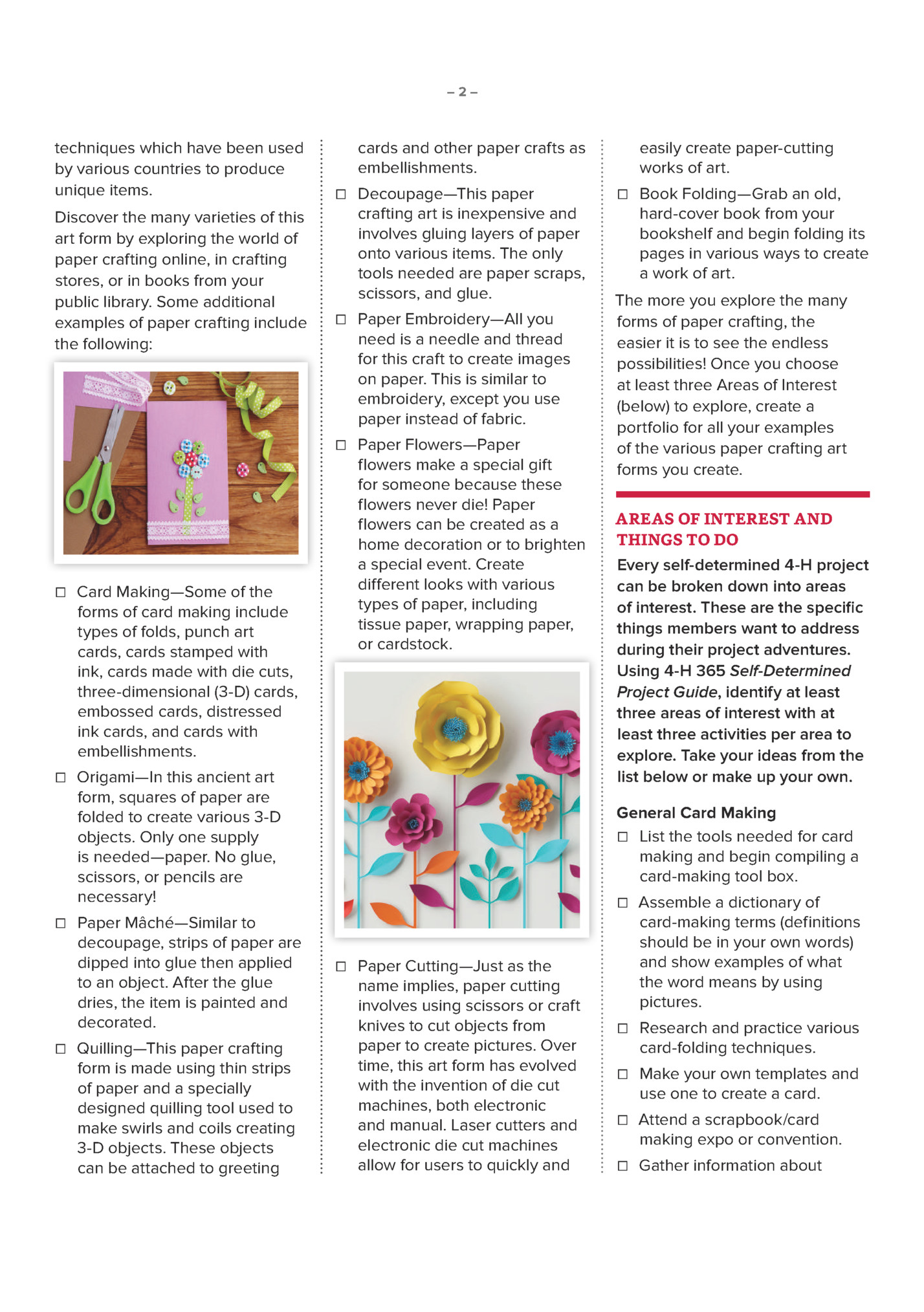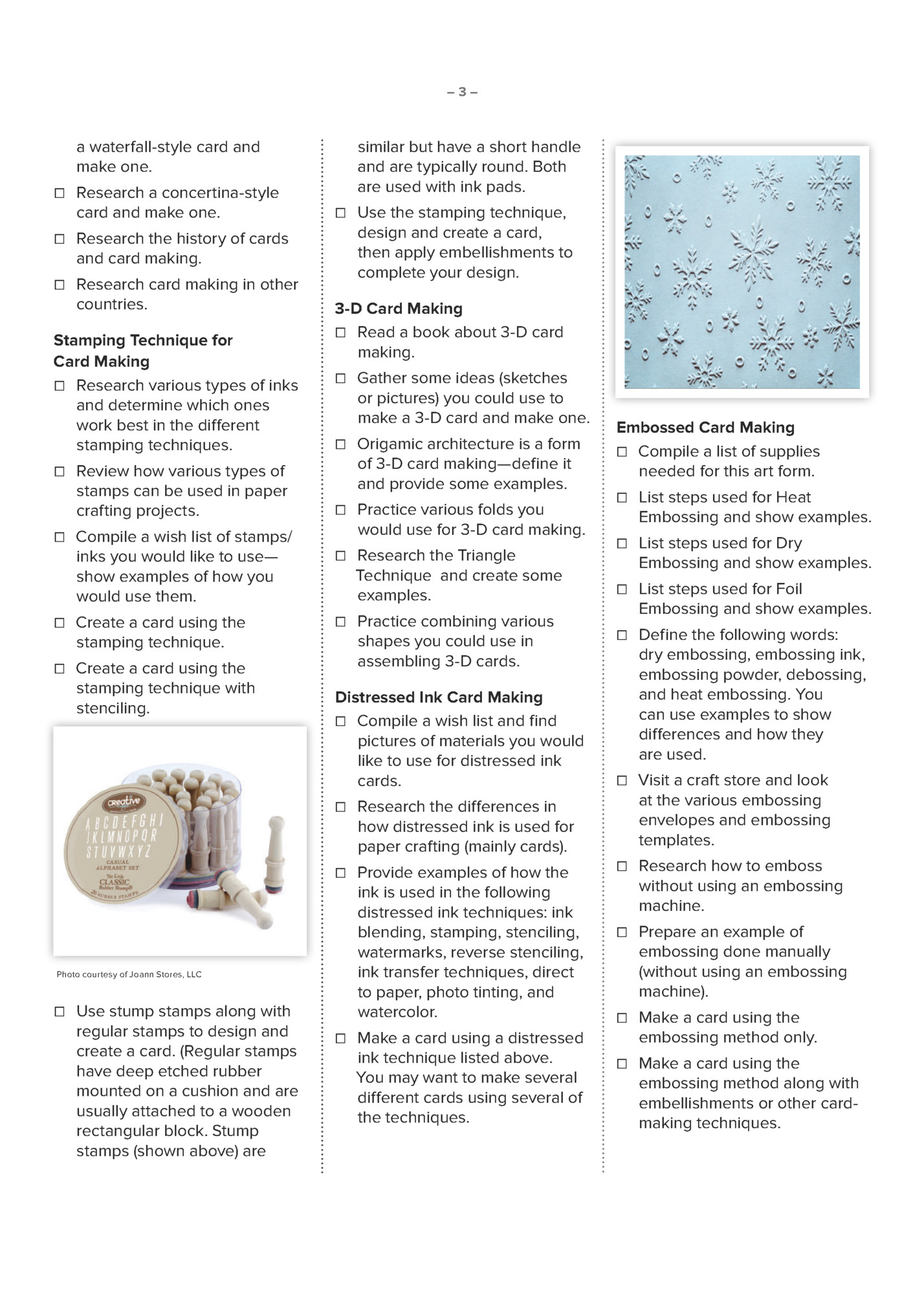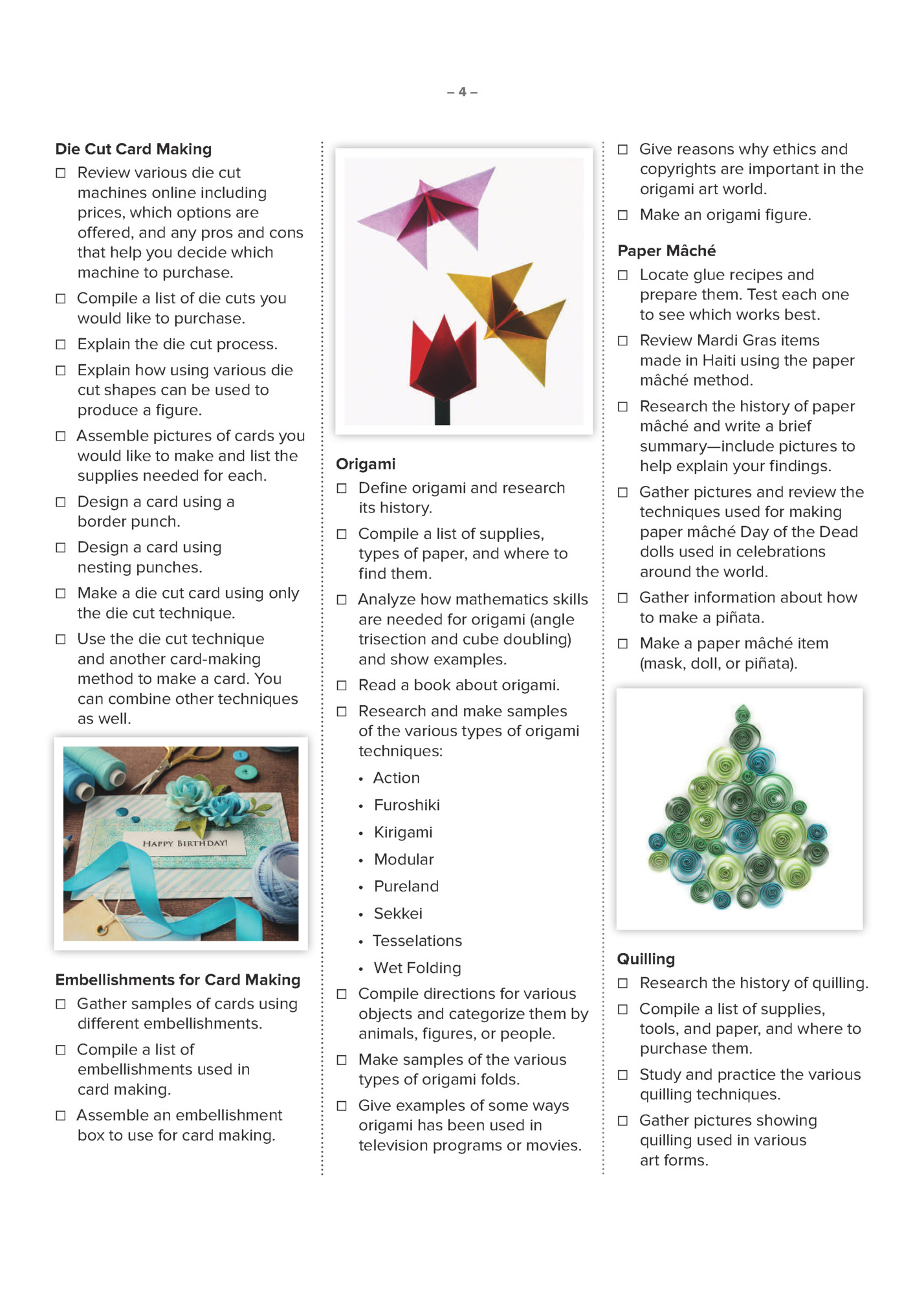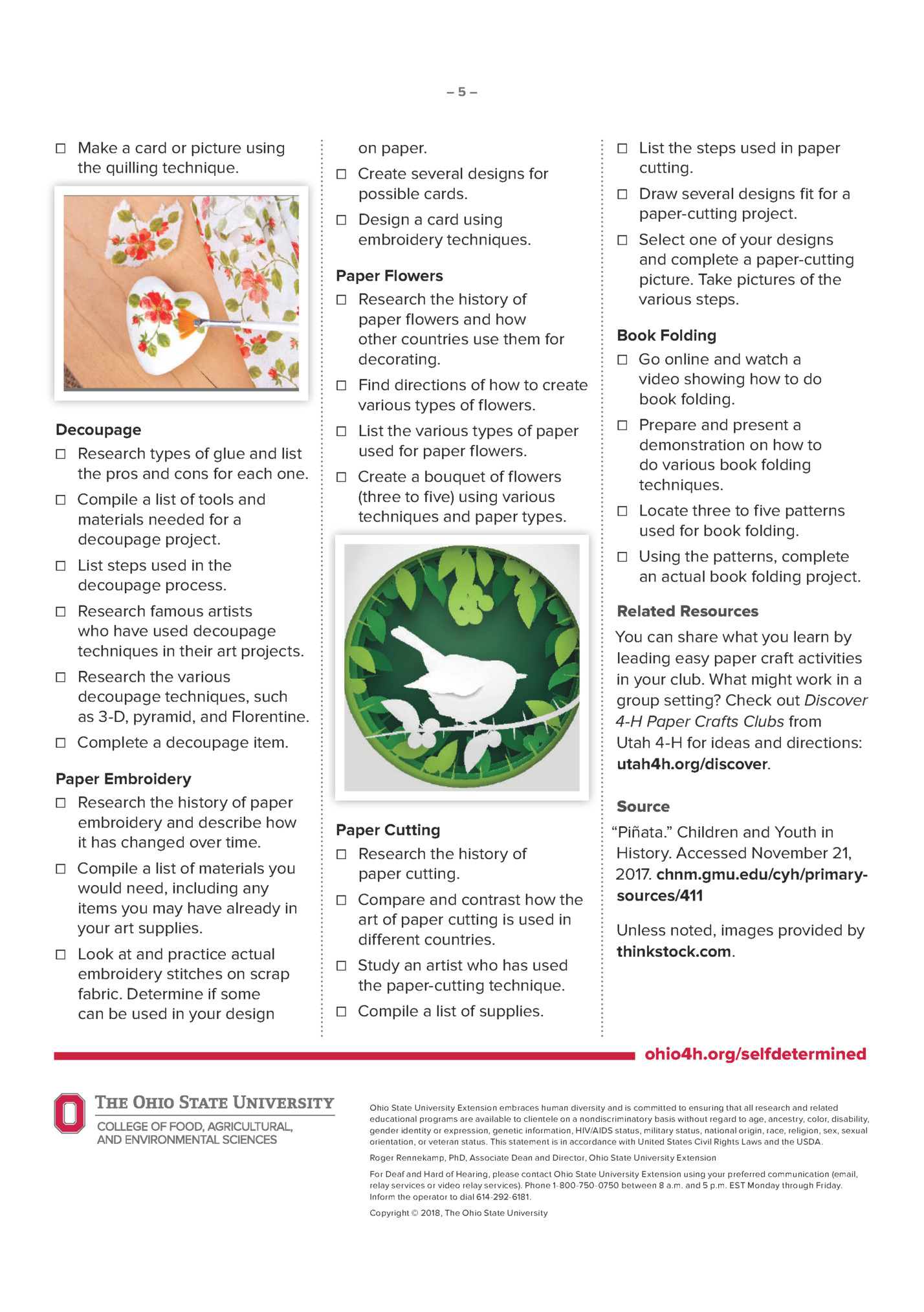OHIO STATE UNIVERSITY EXTENSION PROJECT IDEA STARTER Paper Crafting By Tammie Strawser, Assistant Superintendent, 4-H Creative Arts Days, Ohio State Fair; Franklin County 4-H Volunteer and Alumnus. Reviewed by Tracy Nider, Extension Program Coordinator, 4-H Youth Development, Ohio State University Extension Paper crafting offers a variety of ways to express yourself with fascinating crafting opportunities. This art form is very popular and can be used in various situations including educational, therapeutic, or recreational. Paper crafting comes in many forms but the main supply, as the name implies, is paper. Many of the other supplies can be found around the house, making this an inexpensive hobby. Since its growth in popularity—especially in greeting-card making— craft stores have entire departments designed to help beginners join in the fun and experienced crafters improve. When purchasing supplies, do some research first. Determine how you will use the item and how often you will use it. This is especially true when purchasing more expensive items such as die cut or embossing machines. Always prepare a budget and shopping list before you go shopping. Keeping to purchases on your shopping list helps you stay within your budget. Many items can attract your attention, but preparing ahead of time keeps you from buying something you may not actually need. Card making is currently the most popular form of paper crafting, but many other crafts are included in this fun and expressive hobby. Some forms can be traced back to the historical and cultural roots of other countries. Many paper crafting forms began because of the easy availability and low cost of paper. Piñatas, Day of the Dead dolls, and masks are examples of paper crafts used in holiday celebrations. Some cultures have taken a craft form from another country and incorporated it into their own. The origin of the piñata can be traced to China, where paper was first made. Today, piñatas are used all over the world as part of special celebrations. Several types of paper crafting include the layering of paper and then holding them together with glue or glue-like substances. Paper mâché and decoupage are examples of paper layering PLAN YOUR PROJECT Use this idea starter AND publication 4-H 365 Self-Determined Project Guide as the starting place for your 4-H self-determined project. The Self-Determined Project Guide is available from your county OSU Extension office or on the Web at ohio4h.org/selfdetermined. You may choose to do a little or a lot depending on your level of interest. Be sure to register your project with your county OSU Extension office.

techniques which have been used by various countries to produce unique items. Discover the many varieties of this art form by exploring the world of paper crafting online, in crafting stores, or in books from your public library. Some additional examples of paper crafting include the following: ☐☐ Card Making—Some of the forms of card making include types of folds, punch art cards, cards stamped with ink, cards made with die cuts, three-dimensional (3-D) cards, embossed cards, distressed ink cards, and cards with embellishments. cards and other paper crafts as embellishments. ☐☐ Decoupage—This paper crafting art is inexpensive and involves gluing layers of paper onto various items. The only tools needed are paper scraps, scissors, and glue. ☐☐ Paper Embroidery—All you need is a needle and thread for this craft to create images on paper. This is similar to embroidery, except you use paper instead of fabric. ☐☐ Paper Flowers—Paper flowers make a special gift for someone because these flowers never die! Paper flowers can be created as a home decoration or to brighten a special event. Create different looks with various types of paper, including tissue paper, wrapping paper, or cardstock. ☐☐ Origami—In this ancient art form, squares of paper are folded to create various 3-D objects. Only one supply is needed—paper. No glue, scissors, or pencils are necessary! ☐☐ Paper Mâché—Similar to decoupage, strips of paper are dipped into glue then applied to an object. After the glue dries, the item is painted and decorated. ☐☐ Quilling—This paper crafting form is made using thin strips of paper and a specially designed quilling tool used to make swirls and coils creating 3-D objects. These objects can be attached to greeting easily create paper-cutting works of art. ☐☐ Book Folding—Grab an old, hard-cover book from your bookshelf and begin folding its pages in various ways to create a work of art. The more you explore the many forms of paper crafting, the easier it is to see the endless possibilities! Once you choose at least three Areas of Interest (below) to explore, create a portfolio for all your examples of the various paper crafting art forms you create. AREAS OF INTEREST AND THINGS TO DO Every self-determined 4-H project can be broken down into areas of interest. These are the specific things members want to address during their project adventures. Using 4-H 365 Self-Determined Project Guide, identify at least three areas of interest with at least three activities per area to explore. Take your ideas from the list below or make up your own. General Card Making ☐☐ List the tools needed for card making and begin compiling a card-making tool box. ☐☐ Paper Cutting—Just as the name implies, paper cutting involves using scissors or craft knives to cut objects from paper to create pictures. Over time, this art form has evolved with the invention of die cut machines, both electronic and manual. Laser cutters and electronic die cut machines allow for users to quickly and ☐☐ Assemble a dictionary of card-making terms (definitions should be in your own words) and show examples of what the word means by using pictures. ☐☐ Research and practice various card-folding techniques. ☐☐ Make your own templates and use one to create a card. ☐☐ Attend a scrapbook/card making expo or convention. ☐☐ Gather information about

a waterfall-style card and make one. ☐☐ Research a concertina-style card and make one. ☐☐ Research the history of cards and card making. ☐☐ Research card making in other countries. Stamping Technique for Card Making ☐☐ Research various types of inks and determine which ones work best in the different stamping techniques. ☐☐ Review how various types of stamps can be used in paper crafting projects. ☐☐ Compile a wish list of stamps/ inks you would like to use— show examples of how you would use them. ☐☐ Create a card using the stamping technique. ☐☐ Create a card using the stamping technique with stenciling. similar but have a short handle and are typically round. Both are used with ink pads. ☐☐ Use the stamping technique, design and create a card, then apply embellishments to complete your design. 3-D Card Making ☐☐ Read a book about 3-D card making. ☐☐ Gather some ideas (sketches or pictures) you could use to make a 3-D card and make one. ☐☐ Origamic architecture is a form of 3-D card making—define it and provide some examples. ☐☐ Practice various folds you would use for 3-D card making. ☐☐ Research the Triangle Technique and create some examples. ☐☐ Practice combining various shapes you could use in assembling 3-D cards. Distressed Ink Card Making ☐☐ Compile a wish list and find pictures of materials you would like to use for distressed ink cards. ☐☐ Research the differences in how distressed ink is used for paper crafting (mainly cards). Photo courtesy of Joann Stores, LLC ☐☐ Use stump stamps along with regular stamps to design and create a card. (Regular stamps have deep etched rubber mounted on a cushion and are usually attached to a wooden rectangular block. Stump stamps (shown above) are ☐☐ Provide examples of how the ink is used in the following distressed ink techniques: ink blending, stamping, stenciling, watermarks, reverse stenciling, ink transfer techniques, direct to paper, photo tinting, and watercolor. ☐☐ Make a card using a distressed ink technique listed above. You may want to make several different cards using several of the techniques. Embossed Card Making ☐☐ Compile a list of supplies needed for this art form. ☐☐ List steps used for Heat Embossing and show examples. ☐☐ List steps used for Dry Embossing and show examples. ☐☐ List steps used for Foil Embossing and show examples. ☐☐ Define the following words: dry embossing, embossing ink, embossing powder, debossing, and heat embossing. You can use examples to show differences and how they are used. ☐☐ Visit a craft store and look at the various embossing envelopes and embossing templates. ☐☐ Research how to emboss without using an embossing machine. ☐☐ Prepare an example of embossing done manually (without using an embossing machine). ☐☐ Make a card using the embossing method only. ☐☐ Make a card using the embossing method along with embellishments or other cardmaking techniques.

Die Cut Card Making ☐☐ Review various die cut machines online including prices, which options are offered, and any pros and cons that help you decide which machine to purchase. ☐☐ Give reasons why ethics and copyrights are important in the origami art world. ☐☐ Make an origami figure. Paper Mâché ☐☐ Locate glue recipes and prepare them. Test each one to see which works best. ☐☐ Compile a list of die cuts you would like to purchase. ☐☐ Review Mardi Gras items made in Haiti using the paper mâché method. ☐☐ Explain the die cut process. ☐☐ Explain how using various die cut shapes can be used to produce a figure. ☐☐ Assemble pictures of cards you would like to make and list the supplies needed for each. ☐☐ Design a card using a border punch. ☐☐ Design a card using nesting punches. ☐☐ Make a die cut card using only the die cut technique. ☐☐ Use the die cut technique and another card-making method to make a card. You can combine other techniques as well. Origami ☐☐ Define origami and research its history. ☐☐ Compile a list of supplies, types of paper, and where to find them. ☐☐ Analyze how mathematics skills are needed for origami (angle trisection and cube doubling) and show examples. ☐☐ Research the history of paper mâché and write a brief summary—include pictures to help explain your findings. ☐☐ Gather pictures and review the techniques used for making paper mâché Day of the Dead dolls used in celebrations around the world. ☐☐ Gather information about how to make a piñata. ☐☐ Make a paper mâché item (mask, doll, or piñata). ☐☐ Read a book about origami. ☐☐ Research and make samples of the various types of origami techniques: • Action • Furoshiki • Kirigami • Modular • Pureland • Sekkei • Tesselations Embellishments for Card Making ☐☐ Gather samples of cards using different embellishments. ☐☐ Compile a list of embellishments used in card making. ☐☐ Assemble an embellishment box to use for card making. • Wet Folding ☐☐ Compile directions for various objects and categorize them by animals, figures, or people. ☐☐ Make samples of the various types of origami folds. ☐☐ Give examples of some ways origami has been used in television programs or movies. Quilling ☐☐ Research the history of quilling. ☐☐ Compile a list of supplies, tools, and paper, and where to purchase them. ☐☐ Study and practice the various quilling techniques. ☐☐ Gather pictures showing quilling used in various art forms.

☐☐ Make a card or picture using the quilling technique. on paper. ☐☐ Create several designs for possible cards. ☐☐ Design a card using embroidery techniques. Paper Flowers ☐☐ Research the history of paper flowers and how other countries use them for decorating. ☐☐ Find directions of how to create various types of flowers. Decoupage ☐☐ Research types of glue and list the pros and cons for each one. ☐☐ Compile a list of tools and materials needed for a decoupage project. ☐☐ List the various types of paper used for paper flowers. ☐☐ Create a bouquet of flowers (three to five) using various techniques and paper types. ☐☐ Research famous artists who have used decoupage techniques in their art projects. Book Folding ☐☐ Go online and watch a video showing how to do book folding. ☐☐ Prepare and present a demonstration on how to do various book folding techniques. ☐☐ Locate three to five patterns used for book folding. You can share what you learn by leading easy paper craft activities in your club. What might work in a group setting? Check out Discover 4-H Paper Crafts Clubs from Utah 4-H for ideas and directions: utah4h.org/discover. ☐☐ Complete a decoupage item. ☐☐ Look at and practice actual embroidery stitches on scrap fabric. Determine if some can be used in your design ☐☐ Select one of your designs and complete a paper-cutting picture. Take pictures of the various steps. Related Resources ☐☐ Research the various decoupage techniques, such as 3-D, pyramid, and Florentine. ☐☐ Compile a list of materials you would need, including any items you may have already in your art supplies. ☐☐ Draw several designs fit for a paper-cutting project. ☐☐ Using the patterns, complete an actual book folding project. ☐☐ List steps used in the decoupage process. Paper Embroidery ☐☐ Research the history of paper embroidery and describe how it has changed over time. ☐☐ List the steps used in paper cutting. Source Paper Cutting ☐☐ Research the history of paper cutting. ☐☐ Compare and contrast how the art of paper cutting is used in different countries. ☐☐ Study an artist who has used the paper-cutting technique. “Piñata.” Children and Youth in History. Accessed November 21, 2017. chnm.gmu.edu/cyh/primarysources/411 Unless noted, images provided by thinkstock.com. ☐☐ Compile a list of supplies. ohio4h.org/selfdetermined Ohio State University Extension embraces human diversity and is committed to ensuring that all research and related educational programs are available to clientele on a nondiscriminatory basis without regard to age, ancestry, color, disability, gender identity or expression, genetic information, HIV/AIDS status, military status, national origin, race, religion, sex, sexual orientation, or veteran status. This statement is in accordance with United States Civil Rights Laws and the USDA. Roger Rennekamp, PhD, Associate Dean and Director, Ohio State University Extension For Deaf and Hard of Hearing, please contact Ohio State University Extension using your preferred communication (email, relay services or video relay services). Phone 1-800-750-0750 between 8 a.m. and 5 p.m. EST Monday through Friday. Inform the operator to dial 614-292-6181. Copyright © 2018, The Ohio State University

Fleepit Digital © 2021